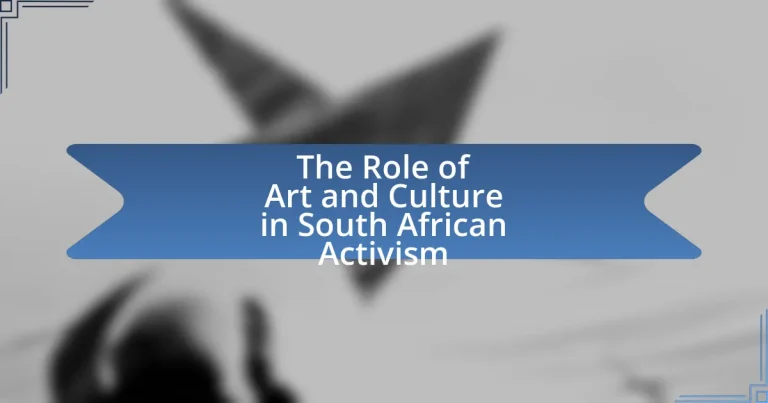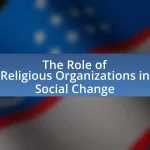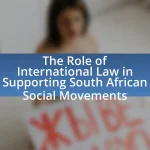The article examines the significant role of art and culture in South African activism, highlighting how these mediums have historically served as tools for social change and political expression. It discusses key historical examples, such as the contributions of musicians like Hugh Masekela and visual artists like William Kentridge during the anti-apartheid movement, illustrating how artistic expressions have mobilized communities and fostered solidarity. The article also explores contemporary artist-activist collaborations, the challenges faced by artists in politically charged environments, and the effective strategies for leveraging art in activism, emphasizing the ongoing importance of cultural narratives in addressing social injustices in South Africa.
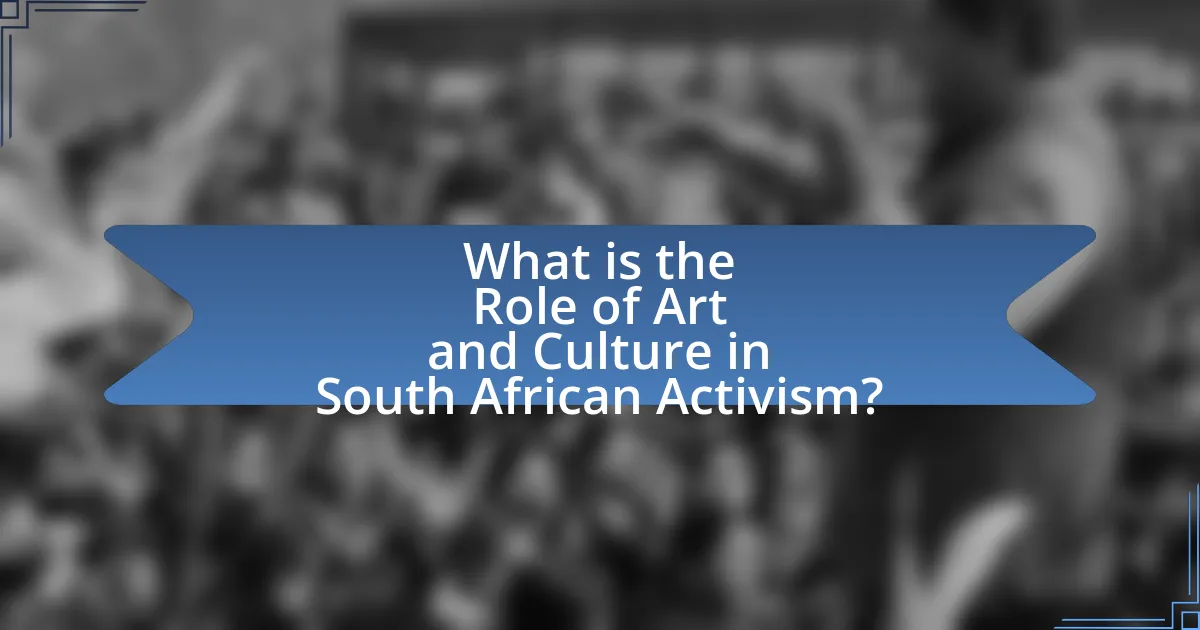
What is the Role of Art and Culture in South African Activism?
Art and culture play a crucial role in South African activism by serving as powerful tools for social change and political expression. Throughout history, artists and cultural figures have used their work to challenge oppression, raise awareness about social injustices, and mobilize communities. For instance, during the apartheid era, music, literature, and visual arts became mediums for resistance, with figures like Miriam Makeba and the visual artist Willie Bester using their platforms to highlight the struggles against racial discrimination. The Truth and Reconciliation Commission in the late 1990s also recognized the importance of cultural narratives in healing and understanding the past, emphasizing how storytelling and artistic expression can foster dialogue and reconciliation. Thus, art and culture not only reflect societal issues but actively contribute to the activism landscape in South Africa by inspiring collective action and fostering a sense of identity and solidarity among marginalized communities.
How has art historically influenced activism in South Africa?
Art has historically influenced activism in South Africa by serving as a powerful medium for social and political expression. During the apartheid era, artists utilized various forms of art, including music, literature, and visual arts, to challenge oppressive regimes and raise awareness about human rights violations. For instance, the music of artists like Hugh Masekela and Miriam Makeba became anthems for the anti-apartheid movement, galvanizing support both locally and internationally. Additionally, visual artists such as William Kentridge used their work to critique the socio-political landscape, effectively communicating the struggles of marginalized communities. This artistic engagement not only inspired activism but also fostered a sense of unity and identity among South Africans, demonstrating the integral role of art in the fight for justice and equality.
What are some key historical examples of art used in activism?
Key historical examples of art used in activism include the works of South African artists during the anti-apartheid movement, such as the music of Hugh Masekela and the visual art of the Black Consciousness Movement. Hugh Masekela’s song “Soweto Blues” became an anthem for the struggle against apartheid, highlighting the plight of black South Africans. Additionally, the visual art produced by artists like Willie Bester and the collective work of the artists involved in the “Art Against Apartheid” campaign served to raise awareness and mobilize support against racial oppression. These artistic expressions were crucial in conveying the emotional and social realities of the struggle, effectively influencing public opinion and policy.
How did cultural movements shape the anti-apartheid struggle?
Cultural movements significantly shaped the anti-apartheid struggle by mobilizing public sentiment and fostering a sense of unity among diverse groups opposing racial segregation. Through music, literature, and visual arts, these movements articulated the injustices of apartheid, raising awareness both locally and internationally. For instance, the music of artists like Hugh Masekela and Miriam Makeba became anthems of resistance, galvanizing support and inspiring activism. Additionally, the cultural boycott of South Africa, endorsed by organizations like Artists Against Apartheid, effectively isolated the apartheid regime and highlighted the global condemnation of its policies. This cultural activism not only provided a platform for voices of dissent but also reinforced the political messages of the anti-apartheid movement, making art a powerful tool for social change.
Why is culture significant in the context of South African activism?
Culture is significant in the context of South African activism because it serves as a powerful tool for expression, identity, and mobilization against oppression. Throughout South Africa’s history, cultural forms such as music, literature, and visual arts have been utilized to convey messages of resistance and solidarity, particularly during the anti-apartheid movement. For example, the song “Nkosi Sikelel’ iAfrika” became an anthem for the struggle against apartheid, symbolizing hope and unity among diverse communities. Additionally, cultural events and festivals have played a crucial role in fostering community engagement and raising awareness about social issues, thereby reinforcing the collective identity necessary for effective activism.
What cultural elements are most commonly associated with activism?
Cultural elements most commonly associated with activism include art, music, literature, and performance. These elements serve as powerful tools for expression and mobilization, often reflecting societal issues and inspiring change. For instance, during the anti-apartheid movement in South Africa, artists like Miriam Makeba and the band Juluka used music to raise awareness and unite people against oppression. Similarly, visual art, such as the works of artists like William Kentridge, has been instrumental in critiquing political injustices and fostering dialogue. Literature, including the writings of authors like Nadine Gordimer, has also played a crucial role in articulating the struggles and aspirations of marginalized communities. These cultural forms not only document the realities of activism but also galvanize support and encourage participation in social movements.
How do cultural expressions foster community and solidarity?
Cultural expressions foster community and solidarity by creating shared experiences that unite individuals around common values and identities. These expressions, such as music, dance, and visual arts, serve as platforms for collective storytelling and emotional connection, which are essential in building social cohesion. For instance, during the anti-apartheid movement in South Africa, artists like Hugh Masekela and Miriam Makeba used music to inspire unity and resistance, effectively mobilizing communities against oppression. This historical context illustrates how cultural expressions can galvanize collective action and reinforce a sense of belonging among diverse groups.
What forms of art are prevalent in South African activism?
Visual art, music, theater, and literature are prevalent forms of art in South African activism. Visual art, including murals and graffiti, often conveys powerful political messages and social commentary, reflecting the struggles against apartheid and ongoing issues of inequality. Music, particularly genres like hip-hop and protest songs, serves as a rallying cry for social justice, with artists like Hugh Masekela and Brenda Fassie using their platforms to address political issues. Theater, through plays and performances, engages audiences in critical discussions about societal challenges, exemplified by works from companies like the Market Theatre. Literature, including poetry and novels, articulates the experiences and aspirations of marginalized communities, with authors like Nadine Gordimer and Zakes Mda highlighting the complexities of South African identity and resistance. These art forms collectively contribute to raising awareness, fostering dialogue, and inspiring action within the context of activism in South Africa.
How do visual arts contribute to social change?
Visual arts contribute to social change by raising awareness, challenging societal norms, and fostering dialogue around critical issues. For instance, in South Africa, artists like William Kentridge use their work to address themes of apartheid and social justice, prompting public discourse and reflection. The visual arts serve as a powerful medium for activism, as seen in the 2012 “Rhodes Must Fall” movement, where visual art was utilized to critique colonial legacies and advocate for transformation in educational institutions. This demonstrates that visual arts not only reflect societal issues but also mobilize communities towards collective action and change.
What role does music play in mobilizing communities?
Music plays a crucial role in mobilizing communities by fostering unity and collective identity among individuals. It serves as a powerful tool for communication, allowing people to express shared experiences and emotions, which can galvanize action. For instance, during the anti-apartheid movement in South Africa, songs like “Nkosi Sikelel’ iAfrika” became anthems that inspired solidarity and resistance against oppression. Research indicates that music can enhance social cohesion, as it often brings people together in communal settings, reinforcing bonds and motivating collective efforts toward social change.
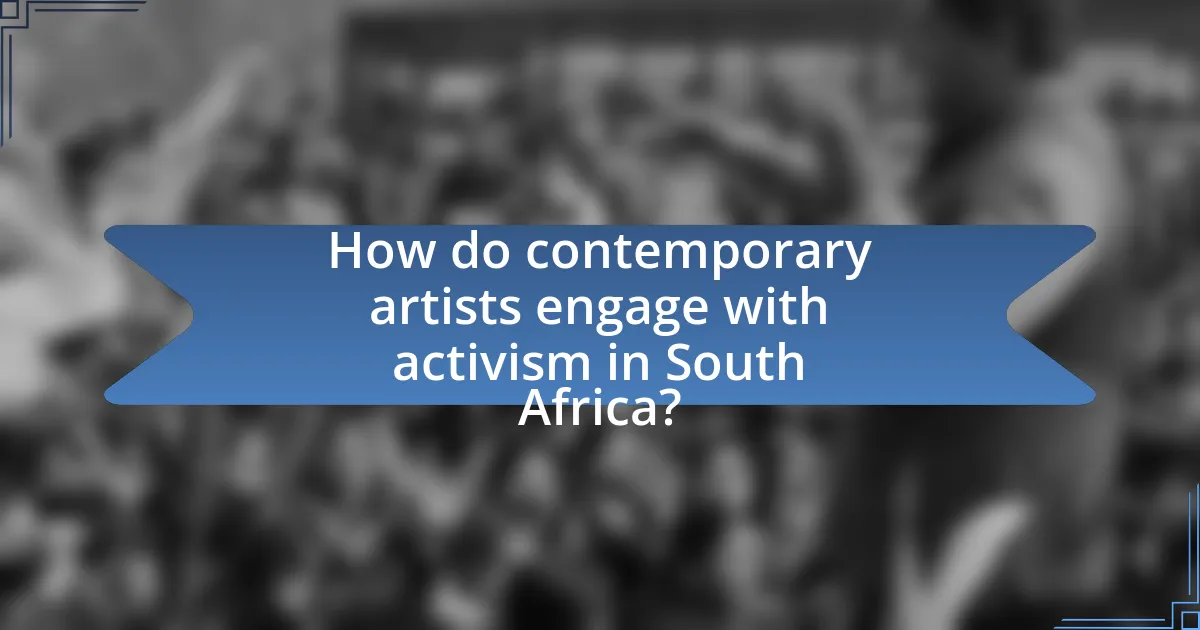
How do contemporary artists engage with activism in South Africa?
Contemporary artists in South Africa engage with activism by using their art to address social issues, challenge injustices, and promote dialogue. For instance, artists like Zanele Muholi focus on LGBTQ+ rights and representation, while others, such as William Kentridge, tackle themes of apartheid and its aftermath. Their works often serve as a platform for marginalized voices, raising awareness about issues like gender inequality, land reform, and environmental concerns. This engagement is evident in public installations, performances, and exhibitions that provoke thought and inspire action, reflecting the ongoing struggles within South African society.
What themes are prevalent in modern South African activist art?
Modern South African activist art prominently features themes of social justice, identity, and resistance. These themes reflect the ongoing struggles against inequality, racism, and political oppression in the country. For instance, artists often address the legacy of apartheid and its impact on contemporary society, using their work to challenge systemic injustices and advocate for marginalized communities. The use of visual storytelling and performance art serves as a powerful medium for raising awareness and fostering dialogue around these critical issues, as seen in the works of artists like Zanele Muholi and William Kentridge, who engage with themes of gender, sexuality, and historical memory.
How do artists address issues of inequality and injustice?
Artists address issues of inequality and injustice by using their work as a platform for social commentary and activism. Through various mediums such as visual art, music, and performance, they highlight systemic issues, provoke thought, and inspire action. For instance, South African artists like William Kentridge and Zanele Muholi create pieces that reflect the struggles against apartheid and ongoing social disparities, effectively raising awareness and fostering dialogue. Their art often incorporates historical references and personal narratives, making the issues relatable and urgent. This approach not only engages audiences but also mobilizes communities towards collective action against injustice.
What mediums are most effective for contemporary activism?
Digital platforms, particularly social media, are the most effective mediums for contemporary activism. These platforms enable rapid dissemination of information, mobilization of supporters, and engagement with a global audience. For instance, movements like #FeesMustFall in South Africa utilized Twitter and Facebook to organize protests and share experiences, leading to significant policy discussions and changes in higher education funding. Additionally, visual art forms, such as murals and street art, serve as powerful tools for conveying messages and fostering community dialogue, exemplified by the work of artists like Faith47, who address social issues through public installations.
How do collaborations between artists and activists enhance impact?
Collaborations between artists and activists enhance impact by merging creative expression with social advocacy, thereby amplifying messages and reaching broader audiences. This synergy allows for innovative storytelling that resonates emotionally, making complex social issues more accessible and engaging. For instance, the collaboration between South African artists and anti-apartheid activists in the 1980s utilized music, visual arts, and theater to mobilize communities and raise awareness, significantly contributing to the anti-apartheid movement’s visibility and urgency. Such partnerships not only foster community engagement but also inspire action, as seen in campaigns like “Art for Social Change,” which leverage artistic platforms to address contemporary social justice issues.
What are some successful examples of artist-activist partnerships?
Successful examples of artist-activist partnerships include the collaboration between South African musician Hugh Masekela and anti-apartheid movements, where his music served as a powerful tool for social change. Masekela’s song “Soweto Blues” became an anthem for the struggle against apartheid, highlighting the plight of those affected by the regime. Another notable partnership is between visual artist William Kentridge and various social justice initiatives, where his animated films and installations address issues such as inequality and human rights. Kentridge’s work has been instrumental in raising awareness and fostering dialogue around these critical topics. Additionally, the collaboration of the South African theatre company Handspring Puppet Company with the anti-apartheid movement showcased how performance art can effectively communicate political messages and mobilize communities. These partnerships illustrate the significant impact that artists can have in activism, using their platforms to advocate for change and inspire action.
How do these collaborations influence public perception and policy?
Collaborations in art and culture significantly influence public perception and policy by fostering community engagement and raising awareness about social issues. For instance, initiatives like the “Art for Social Change” movement in South Africa have utilized collaborative art projects to address topics such as inequality and human rights, effectively shaping public discourse. Research indicates that these artistic collaborations can lead to increased civic participation and influence policymakers by highlighting community needs and perspectives, as evidenced by the success of campaigns like the “#FeesMustFall” movement, which combined art, music, and activism to advocate for educational reform.
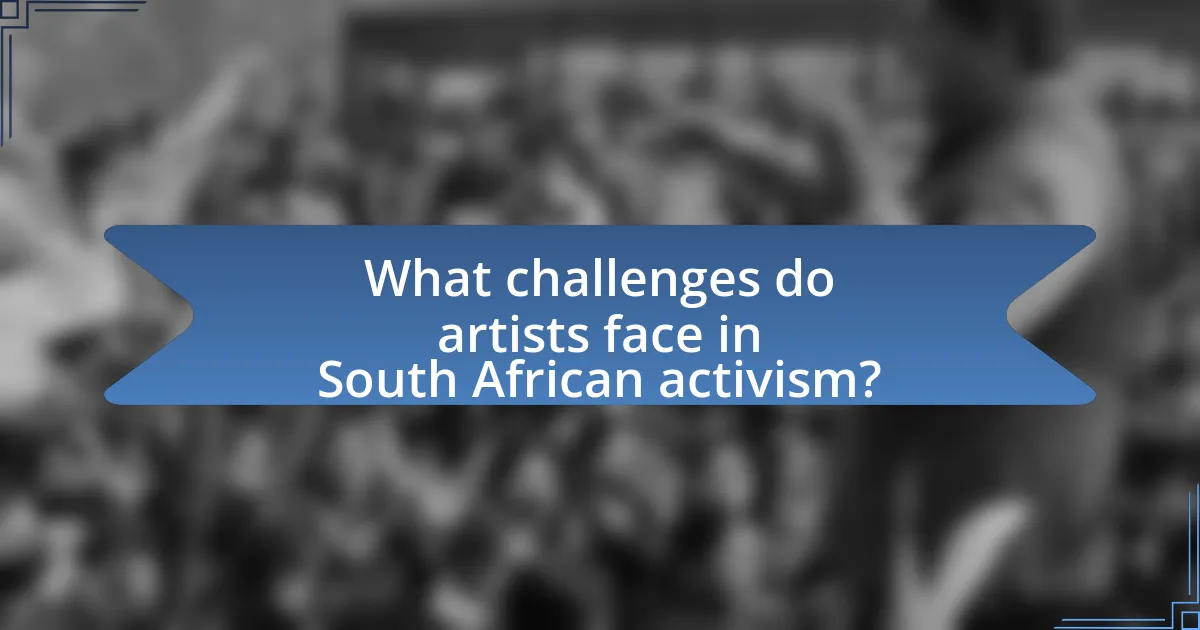
What challenges do artists face in South African activism?
Artists in South African activism face significant challenges, including censorship, funding limitations, and societal backlash. Censorship often arises from government or institutional pressures that restrict artistic expression, particularly when addressing sensitive political issues. Funding limitations hinder artists’ ability to produce and promote their work, as many rely on grants or sponsorships that may not be readily available. Additionally, societal backlash can manifest in public criticism or threats, particularly when art challenges prevailing norms or power structures. These challenges are compounded by the historical context of apartheid, which has left a legacy of mistrust and division that artists must navigate in their activism.
What are the risks associated with politically charged art?
Politically charged art carries several risks, including censorship, backlash from authorities, and potential harm to the artist’s reputation or safety. Censorship can occur when governments or institutions suppress artworks that challenge political norms, as seen in various countries where dissenting voices are silenced. Backlash from authorities may manifest in legal actions or public condemnation, which can deter artists from expressing their views. Additionally, artists may face threats or violence, particularly in politically unstable regions, as evidenced by incidents where activists have been targeted for their work. These risks highlight the precarious balance artists must navigate when engaging with sensitive political themes.
How do censorship and government policies affect artistic expression?
Censorship and government policies significantly restrict artistic expression by imposing limitations on what can be created, shared, and performed. In South Africa, for example, the apartheid regime enforced strict censorship laws that suppressed dissenting voices and controlled cultural narratives, leading to a stifling of creativity and a lack of diverse representation in the arts. Historical evidence shows that artists faced imprisonment, exile, or violence for their work, which challenged the status quo. This suppression not only limited individual expression but also hindered collective movements for social change, as art often serves as a powerful tool for activism and resistance.
What personal and professional consequences do artists encounter?
Artists encounter significant personal and professional consequences, including financial instability, social isolation, and mental health challenges. Financial instability arises from the unpredictable nature of income in the arts, where many artists struggle to secure consistent funding or sales, leading to economic stress. Social isolation can occur as artists often dedicate extensive time to their craft, which may limit their social interactions and support networks. Mental health challenges are prevalent due to the pressures of public scrutiny, criticism, and the emotional toll of creating art that addresses complex social issues. Research indicates that artists are at a higher risk for anxiety and depression, highlighting the need for mental health support within the creative community.
How can art and culture be leveraged for effective activism?
Art and culture can be leveraged for effective activism by using creative expressions to raise awareness, inspire action, and foster community engagement. For instance, visual art, music, and performance can communicate complex social issues in accessible ways, making them resonate with diverse audiences. Historical examples include the role of protest songs during the anti-apartheid movement in South Africa, where artists like Hugh Masekela and Miriam Makeba used their music to mobilize support and convey messages of resistance. Additionally, public art installations and cultural festivals can serve as platforms for dialogue and solidarity, uniting individuals around common causes. Research indicates that culturally relevant activism can enhance emotional connections and motivate collective action, as seen in studies by the University of Cape Town, which highlight the impact of art on social movements.
What strategies can artists use to maximize their impact?
Artists can maximize their impact by engaging with their communities, utilizing social media for broader reach, and collaborating with other activists. Community engagement allows artists to create work that resonates with local issues, fostering a deeper connection with their audience. For instance, artists like William Kentridge have used their art to address social injustices in South Africa, effectively raising awareness and prompting dialogue. Social media platforms enable artists to share their work widely, reaching diverse audiences and amplifying their messages; for example, campaigns like #BlackLivesMatter have shown how art can mobilize support and awareness on a global scale. Collaborating with other activists enhances the effectiveness of their messages, as seen in projects that combine visual art with performance and literature to create multifaceted narratives that resonate more powerfully with the public.
How can communities support artists in their activism efforts?
Communities can support artists in their activism efforts by providing platforms for their work, such as local galleries, public spaces, and community events. These platforms enable artists to showcase their messages and engage the public in critical social issues. For instance, initiatives like the Arts and Culture Trust in South Africa have successfully funded projects that amplify artists’ voices in activism, demonstrating the impact of community support on raising awareness and fostering dialogue around social justice. Additionally, communities can offer financial backing through grants or crowdfunding, which empowers artists to focus on their activism without financial constraints.
What are best practices for engaging with art in activism?
Best practices for engaging with art in activism include fostering collaboration between artists and activists, ensuring inclusivity in artistic representation, and utilizing art as a tool for storytelling and awareness. Collaboration enhances the impact of the message, as seen in the partnership between visual artists and social movements in South Africa, which has historically amplified voices for change. Inclusivity ensures diverse perspectives are represented, reflecting the multifaceted nature of social issues. Additionally, art serves as a powerful medium for storytelling, effectively conveying complex narratives and emotions, which can mobilize communities and inspire action, as demonstrated by the use of murals and performances during the anti-apartheid movement.
